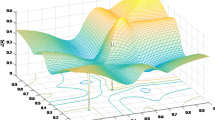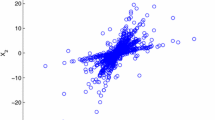Abstract
In this study, a tensor algorithm is proposed to blindly separate an instantaneous linear underdetermined mixture with non-stationary sources and nonnegative mixing matrix. It proceeds in two steps: 1) estimating the mixing matrix and 2) recovering the source signals. First, a canonical tensor model is constructed using a fourth-order cumulant tensor of the observed signals to estimate the mixing matrix. Then, an improved hierarchical alternating least squares algorithm is used to decompose the canonical tensor model, which ensures that all elements of the mixing matrix are positive. Finally, the sources are recovered using a minimum mean-squared error beamformer approach without any hypothetical limitation. We apply two classes of data (speech signals and biomedical signals) to substantiate the effectiveness of the proposed algorithm for underdetermined blind source separation.










Similar content being viewed by others
References
F. Abrard, Y. Deville, A time–frequency blind signal separation method applicable to underdetermined mixtures of dependent sources. Signal Process. 85(7), 1389–1403 (2005)
E. Acar, B. Yener, Unsupervised multiway data analysis: a literature survey. IEEE Trans. Knowl. Data Eng. 21(1), 6–20 (2009)
S. Araki, H. Sawada, R. Mukai, S. Makino, Underdetermined blind sparse source separation for arbitrarily arranged multiple sensors. Signal Process. 87(8), 1833–1847 (2007)
A.J. Bell, T.J. Sejnowski, An information-maximization approach to blind separation and blind deconvolution. Neural Comput. 7(6), 1129–1159 (1995)
J.F. Cardoso, Blind signal separation: statistical principles. Proc. IEEE 86(10), 2009–2025 (1998)
J.F. Cardoso, Higher-order contrasts for independent component analysis. Neural Comput. 11(1), 157–192 (1999)
A. Cichocki, A.H. Phan, C. Caiafa, Flexible HALS algorithms for sparse nonnegative matrix/tensor factorization. in Proceedings MLSP (2008), pp. 73–78
A. Cichocki, R. Zdunek, A.H. Phan, S. Amari, Nonnegative Matrix and Tensor Factorizations: Applications to Exploratory Multi-way Data Analysis and Blind Source Separation (Wiley, United Kingdom, 2009)
L. Cohen, Time–Frequency Analysis: Theory and Applications (Prentice Hall, New York, 1995)
P. Common, Blind identification and source separation in 2\(\times \)3 underdetermined mixtures. IEEE Trans. Signal Process. 52(1), 11–22 (2004)
P. Comon, Independent component analysis, a new concept. Signal Process. 36(3), 287–314 (1994)
Y.C. Eldar, A. Nehorai, P.S.L. Rose, A competitive mean-squared error approach to beamformer. IEEE Trans. Signal Process. 55(11), 5143–5154 (2007)
A. Ferreol, P. Chevalier, L. Albera, Higher order blind separation of nonzero-mean cyclostationary sources. in Proceedings EUSIPCO (2002), pp. 103–106
A. Ferreol, L. Albera, P. Chevalier, Fourth-order blind identification of underdetermined mixtures of sources. IEEE Trans. Signal Process. 53(1), 1640–1653 (2005)
S.N. Ge, M. Han, Principal component analysis tensor decomposition method to remove ocular artifact. in Proceedings ICICIP 2012 (2012), pp. 664–669
A. Hyvarinen, Fast and robust fixed-point algorithms for independent component analysis. IEEE Trans. Neural Netw. 10(3), 626–634 (1999)
M. Jing, T.M. McGinnity, S. Colemean, H.Z. Zhang, A. Fuchs, J.A.S. Kelso, Enhancement of fiber orientation distribution reconstruction in diffusion-weighted imaging by single channel blind source separation. IEEE Trans. Biomed. Eng. 59(2), 363–373 (2012)
A. Jourjine, S. Rickard, O. Yilmaz, Blind separation of disjoint orthogonal signals: demixing n sources from 2 mixtures. in Proceedings ICASSP 2000 (2000), pp. 2985–2988
S.G. Kim, C.D. Yoo, Underdetermined blind source separation based on subspace representation. IEEE Trans. Signal Process. 57(7), 2604–2614 (2009)
T.G. Kolda, B.W. Bader, Tensor decompositions and applications. SIAM Rev. 51(3), 455–500 (2009)
Z. Koldovsky, P. Tichavsky, A.H. Phan, A. Cichocki, A two-stage MMSE beamformer for underdetermined signal separation. IEEE Trans. Signal Process. 20(12), 1227–1230 (2013)
L.D. Lathauwer, J. Castaing, J.F. Cardoso, Fourth-order cumulant-based blind identification of underdetermined mixtures. IEEE Trans. Signal Process. 55(6), 2965–2973 (2007)
L.D. Lathauwer, J. Castating, Blind identification of underdetermined mixtures by simultaneous matrix diagonalization. IEEE Trans. Signal Process. 56(3), 1096–1105 (2008)
Q.V. Le, A. Karpenko, J.Q. Ngiam, A.Y. Ng, ICA with reconstruction cost for efficient overcomplete feature learning. in Proceedings NIPS (2011), pp. 1017–1025
H.L. Liu, C.J. Yao, J.X. Hou, A new algorithm for the underdetermined blind source separation based on sparse component analysis. Int. J. Pattern Recognit. Artif. Intell. 23(1), 71–85 (2009)
N. Mitianoudis, T. Stathaki, Overcomplete source separation using Laplacian mixture models. IEEE Signal Process. Lett. 12(4), 1–9 (2005)
N. Mitianoudis, A generalized directional Laplacian distribution estimation, mixture models and audio source separation. IEEE Trans. Speech Audio Lang. Process. 20(9), 2397–2408 (2012)
G.R. Naik, D.K. Kumar, An overview of independent component analysis and its applications. Informatica 35(1), 63–81 (2011)
G.R. Naik, D.K. Kumar, Dimensional reduction using blind source separation for identifying sources. Int. J. Innov. Comput. Inf. Control. 7(2), 1349–4198 (2011)
G.R. Nail, D.K. Kumar, Determining number of independent source in undercomplete mixture. EURASIP J. Adv. Signal Process. 2009(51), 1–5 (2009)
D. Nion, N.D. Sidiroupoulos, Adaptive algorithm to track the PARAFAC decomposition of a third-order tensor. IEEE Trans. Signal Process. 57(6), 2299–2310 (2009)
D. Nion, K.N. Mokios, N.D. Sidiroupoulos, A. Potamianos, Batch and adaptive PARAFAC-based blind separation of convolutive speech mixtures. IEEE Trans. Speech Audio Lang. Process. 18(6), 1193–1207 (2010)
D.Z. Peng, Y. Xiang, Underdetermined blind source separation based on relaxed sparsity condition of sources. IEEE Trans. Signal Process. 57(2), 809–814 (2009)
A.H. Phan, A. Cichocki, Extended HALS algorithm for nonnegative Tucker decomposition and its applications for multiway analysis and classification. Neural Comput. 74(11), 1956–1969 (2011)
S. Rickard, R. Balan, J. Rosca, Real-time time–frequency based blind source separation. in Proceedings ICA (2001), pp. 651–656
H. Snoussi, J. Idier, Bayesian blind separation of generalized hyperbolic process in noisy and underdetermined mixtures. IEEE Trans. Signal Process. 54(9), 3257–3269 (2006)
K.T. Sweeney, H. Ayaz, T.E. Ward, M. Izzetoglu, S.F. Mcloone, B. Onaral, A methodology for validating artifact removal techniques for physiological signals. IEEE Trans. Inf. Technol. Biomed. 16(5), 918–926 (2012)
P. Tichavsky, Z. Koldovsky, Weight adjusted tensor method for blind separation of underdetermined mixtures of nonstationary source. IEEE Trans. Signal Process. 59(3), 1037–1047 (2011)
E. Vincent, R. Gribonval, C. Fevotte, Performance measurement in blind audio source separation. IEEE Trans. Speech Audio Lang. Process. 14(4), 1462–1469 (2006)
L. Wang, H.P. Ding, F.L. Yin, A region-growing permutation alignment approach in frequency-domain blind source separation of speech mixtures. IEEE Trans. Speech Audio Lang. Process. 19(3), 549–557 (2011)
Y. Zhang, X. Shi, C.H. Chen, Gaussian mixture model-based Bayesian analysis for underdetermined blind source separation. Circuits Syst. Signal Process. 25(1), 81–94 (2006)
H. Zhang, L. Li, W. Li, Independent component analysis based on fast proximal gradient. Circuits Syst. Signal Process. 31(2), 583–593 (2012)
Acknowledgments
This study is supported by the National Nature Science Foundation of China (Project No. 61374154), the Fundamental Research Funds for the Central Universities (DUT13JB08), and the Dalian Municipal Science and Technology Plan Project (2012C014).
Author information
Authors and Affiliations
Corresponding author
Rights and permissions
About this article
Cite this article
Ge, S., Han, J. & Han, M. Nonnegative Mixture for Underdetermined Blind Source Separation Based on a Tensor Algorithm. Circuits Syst Signal Process 34, 2935–2950 (2015). https://doi.org/10.1007/s00034-015-9969-8
Received:
Revised:
Accepted:
Published:
Issue Date:
DOI: https://doi.org/10.1007/s00034-015-9969-8




